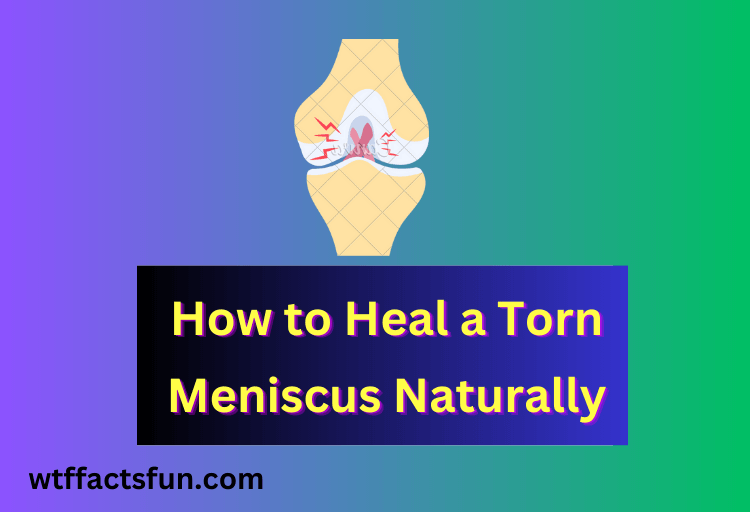
Table of Contents
How to Heal a Torn Meniscus Naturally
How to Heal a Torn Meniscus Naturally: Suffering from a torn meniscus can be a painful and debilitating experience. The meniscus is a rubbery cartilage in the knee joint that acts as a shock absorber. When it tears, it can lead to pain, swelling, and limited mobility. While surgical intervention may be necessary in severe cases, there are natural methods that can aid in the healing process. This article explores various natural remedies, exercises, and preventive measures to support the recovery of a torn meniscus.
Understanding a Torn Meniscus
Causes and Risk Factors
A torn meniscus often occurs due to sudden twisting or rotating movements of the knee, commonly seen in sports or activities that involve quick changes in direction. Aging and degenerative changes in the knee joint can also make the meniscus more susceptible to tears.
Symptoms and Diagnosis
Common symptoms of a torn meniscus include pain, swelling, stiffness, and a sensation of locking or catching in the knee joint. A thorough physical examination by a healthcare professional, coupled with imaging tests such as MRI or arthroscopy, can help diagnose a torn meniscus.
Natural Remedies for Healing a Torn Meniscus
1. Rest and Reduce Weight-Bearing
Resting the affected knee is crucial for healing. Avoid activities that put excessive stress on the knee joint. Using crutches or a knee brace can help reduce weight-bearing and provide support.
2. Apply Cold and Heat Therapy
Applying ice packs to the injured knee can help reduce swelling and inflammation. Heat therapy, such as warm compresses or warm baths, can help increase blood flow and promote healing.
3. Perform Low-Impact Exercises
Engaging in low-impact exercises can help strengthen the muscles around the knee joint and promote stability. Examples include swimming, cycling, and gentle yoga or Pilates exercises.
4. Supportive Braces and Devices
Wearing a knee brace or using supportive devices like crutches or walking aids can provide stability and protect the injured knee during the healing process.
5. Follow a Nutrient-Rich Diet
A balanced diet rich in nutrients can support the body’s natural healing processes. Include foods high in antioxidants, such as fruits, vegetables, whole grains, and lean proteins.
6. Try Natural Anti-Inflammatory Supplements
Certain natural supplements, such as turmeric, ginger, and omega-3 fatty acids, possess anti-inflammatory properties that can help reduce pain and inflammation associated with a torn meniscus.
Physical Therapy and Rehabilitation
Benefits of Physical Therapy
Physical therapy plays a crucial role in rehabilitating a torn meniscus. A skilled physical therapist can guide you through specific exercises and techniques to strengthen the knee, improve range of motion, and promote overall recovery.
Strengthening and Flexibility Exercises
Targeted exercises that focus on strengthening the muscles around the knee, such as quadriceps and hamstrings, can enhance stability and support the healing process. Flexibility exercises help improve range of motion and prevent stiffness.
Range of Motion Exercises
Gentle range of motion exercises, such as knee bends and extensions, can help restore flexibility and promote healing in the knee joint.
Prevention and Lifestyle Considerations
1. Maintain a Healthy Weight
Maintaining a healthy weight reduces stress on the knee joint, lowering the risk of developing or worsening a torn meniscus.
2. Warm-Up and Stretch Before Physical Activities
Engage in proper warm-up exercises and stretching routines before participating in physical activities. This helps prepare the muscles and joints, reducing the risk of injury.
3. Use Proper Body Mechanics
Practice proper body mechanics during movements to avoid excessive strain on the knee joint. This includes using proper form during exercises, lifting objects correctly, and avoiding sudden twisting motions.
4. Avoid Activities with High Risk of Injury
Participate in activities that are low-impact and less likely to cause injury to the knee joint. Avoid high-impact sports or activities with repetitive twisting motions that may put stress on the meniscus.
When to Seek Medical Intervention
While natural methods can aid in healing, severe cases of torn meniscus may require medical intervention. If the pain intensifies, mobility is severely limited, or natural remedies do not provide relief, it is important to consult a healthcare professional for further evaluation and treatment options.
FAQs (Frequently Asked Questions)
How long does it take a meniscus tear to heal without surgery?
The healing time for a meniscus tear without surgery can vary depending on the severity of the tear and individual factors, but it may take several weeks to months with proper rest, rehabilitation, and natural remedies.
Can a meniscus tear heal on its own?
In some cases, small meniscus tears can heal on their own with conservative treatment, such as rest, physical therapy, and natural remedies. However, larger or more severe tears may require surgical intervention for proper healing.
Is walking good or bad for meniscus tear?
Walking can be beneficial for a meniscus tear as it promotes blood flow and helps maintain joint mobility. However, it is essential to avoid activities that exacerbate pain or discomfort and follow medical advice for proper care and rehabilitation.
Is a meniscus tear lifelong?
A meniscus tear is not necessarily lifelong. With appropriate treatment, including rest, rehabilitation, and sometimes surgery, the symptoms can improve, and individuals can regain functionality in their knee.
What are 3 signs of a meniscus tear in the knee?
Three signs of a meniscus tear in the knee include pain, swelling, and a popping or clicking sensation in the joint during movement or bending.
Conclusion
Healing a torn meniscus naturally involves a combination of rest, natural remedies, exercises, and preventive measures. While these methods can promote recovery, it is crucial to listen to your body and seek medical advice when necessary. With patience, proper care, and a holistic approach, individuals can support the healing process and regain strength and mobility in their knees.
Read also:
How Much Does a Chiropractor Cost? Understanding the Expenses of Chiropractic Visits
How to Clean Prefinished Hardwood Floors: A Step-by-Step Guide